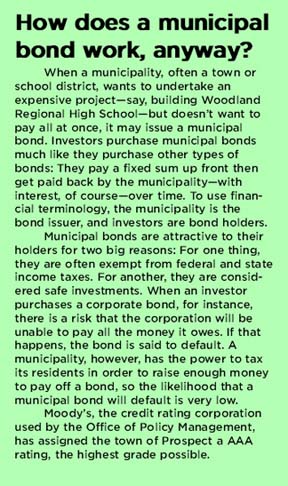 Democratic mayoral challenger Charles Mallon says Prospect’s bond debt exceeds $25 million. Republican incumbent Mayor Bob Chatfield claims the figure is more like $3 million. People are used to politicians disagreeing about facts and figures during campaigns, but a $22 million discrepancy is pretty substantial for a town this size (for perspective, $22 million is enough to educate every child in Prospect for an entire school year).
Democratic mayoral challenger Charles Mallon says Prospect’s bond debt exceeds $25 million. Republican incumbent Mayor Bob Chatfield claims the figure is more like $3 million. People are used to politicians disagreeing about facts and figures during campaigns, but a $22 million discrepancy is pretty substantial for a town this size (for perspective, $22 million is enough to educate every child in Prospect for an entire school year).
What’s a responsible voter to think, just days before casting a ballot? Mallon and Chatfield can’t both be telling the truth, can they?
Well, in a way they can. They’re just measuring debt in very different ways.
Mallon’s figure, which he cited in an interview with Citizen’s News earlier this month, is a combination of Prospect’s bond debt and the town’s share of Regional School District No. 16’s bond debt, as of the fiscal year that ended June 30, 2008. That total is $25,647,441.
If that number seems outdated, keep in mind that it is the most up-to-date figure on record with the state and at Town Hall. Municipal audited financial statements for the fiscal year that ended June 30, 2009 are due to the Office of Policy Management Dec. 31.

Chatfield’s number, presented to Citizen’s News last week in a letter from Republican Town Committee Chairman Tom Galvin, does not include educational bond debt and reflects the town’s debt, as of the fiscal year that ended June 30, 2009. It is $3,075,169
Though Prospect’s 2009 audit report is not yet public, it is possible to estimate the bond debt that will be listed, by subtracting the town’s 2009 bond service payment ($675,701) from its 2008 debt ($3,750,870).
As you can see, the main reason Mallon’s and Chatfield’s figures are so different, is because the first-term Town Council member includes Region 16 debt (of which Prospect is responsible for 61.198 percent, based on current enrollment) and the 32-year mayor does not.
“When you try to disassociate from Region 16, that’s not right,” Mallon says. “That’s not a true picture.”
Chatfield argues that including school debt comes with a qualifier.
“What’s not being said is that most of what we owe, we get back from the state,” he says.
Indeed, the state of Connecticut reimburses Region 16 for 60.63 percent of its bond debt, so the district’s—and, by extension, taxpayers’—burden is considerably less than the bonds’ actual principal and interest.
So what’s the real number?
“We’ve asked Bob for years for an accurate figure of what our debt is, and we’ve never been given true numbers,” Mallon claims. “That’s part of why I’m running. When your own Town Council member has trouble [figuring out Prospect’s bond debt], that’s not right.”

“It’s all in the annual report,” Chatfield counters. “If [Mallon] wants to run the town, he should know those numbers. … If people want to know, they can ask me, same as you. … It’s a non-issue. Taxpayers approved all our bonds at town meetings”
Again, they’re both right, in their own ways. All of the figures listed in this column are public information, and Joe Voter is just as entitled to request them as I am. However, it took half a work day of scouring government Web sites and making phone calls to the Office of the Secretary of the State, Department of Revenue Services, Office of Policy Management and Prospect Town Hall—enduring automated voice messages and call transfers—for me to collect all the data I needed. And I’m a professional journalist.
What I’m not is a professional accountant, but it became clear that if I wanted to answer the question “How much bond debt does Prospect really carry?” I’d have to calculate the debt myself. None of the figures I’d been given seemed entirely fair.
As Mallon points out, the majority of local tax dollars are spent on education, so it seems appropriate to include Prospect’s share of Region 16 debt. Also, OPM factors in school system bond debt when it publishes the annual compendium Municipal Fiscal Indicators.
But as Chatfield notes, the majority of that school district bond debt is covered by the state, a caveat not taken into account by MFI.
So here’s a summary of my math (explained further in the table above), using debt estimates as of the fiscal year that ended June 30, 2009:
- Region 16’s total bond debt: $31,500,992
- Region 16’s total bond debt, after state reimbursement: $12,401,941
- Prospect’s share of Region 16 bond debt, after state reimbursement: $7,589,740
- Prospect’s share of Region 16 bond debt, after state reimbursement, plus town bond debt: $10,664,909
That last number, folks, is what I believe to be the fairest measure of the debt for which you are responsible. It’s not an official figure, but it’s one that actually seems to satisfy both candidates.
“OK,” Chatfield said, when I explained how I arrived at roughly $10.6 million.
“I agree with that,” Mallon added. “I’ll go along with that.”














